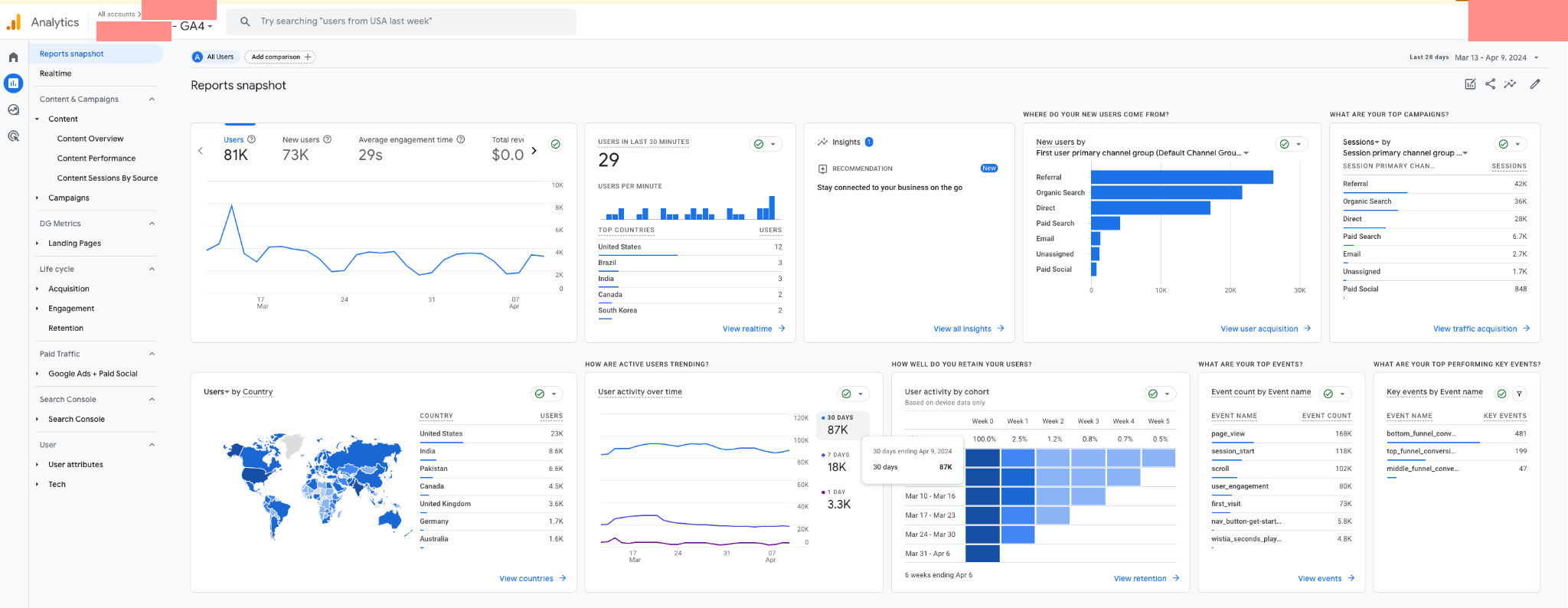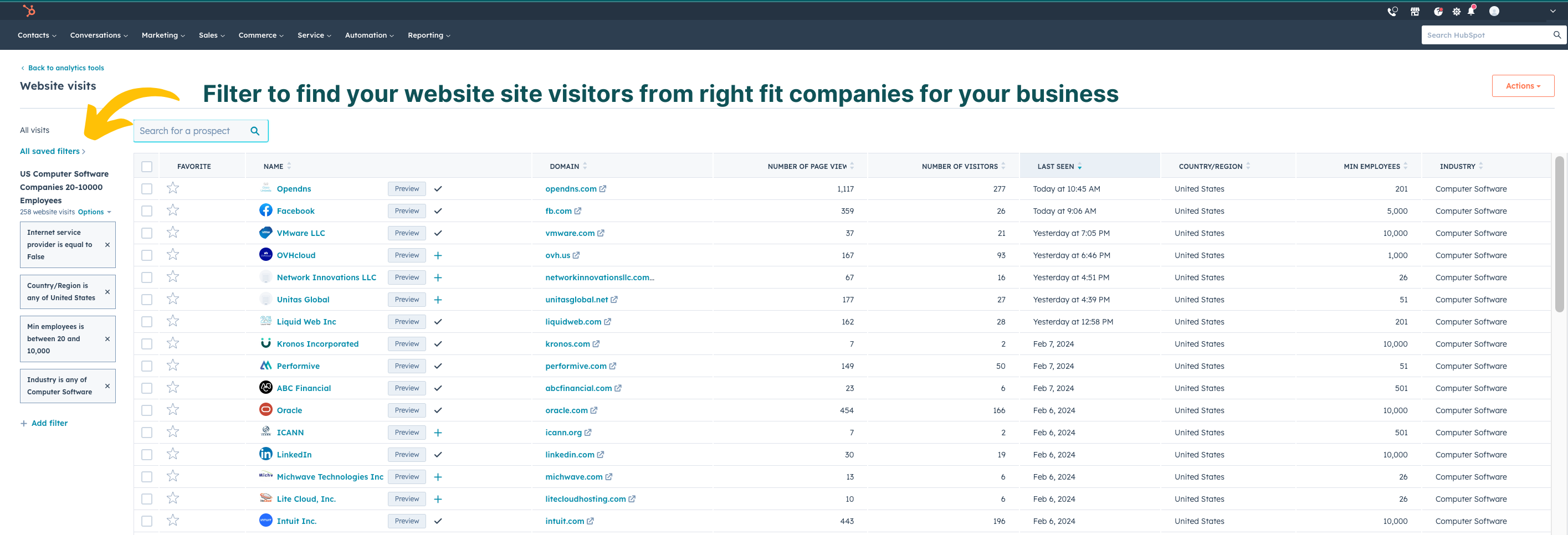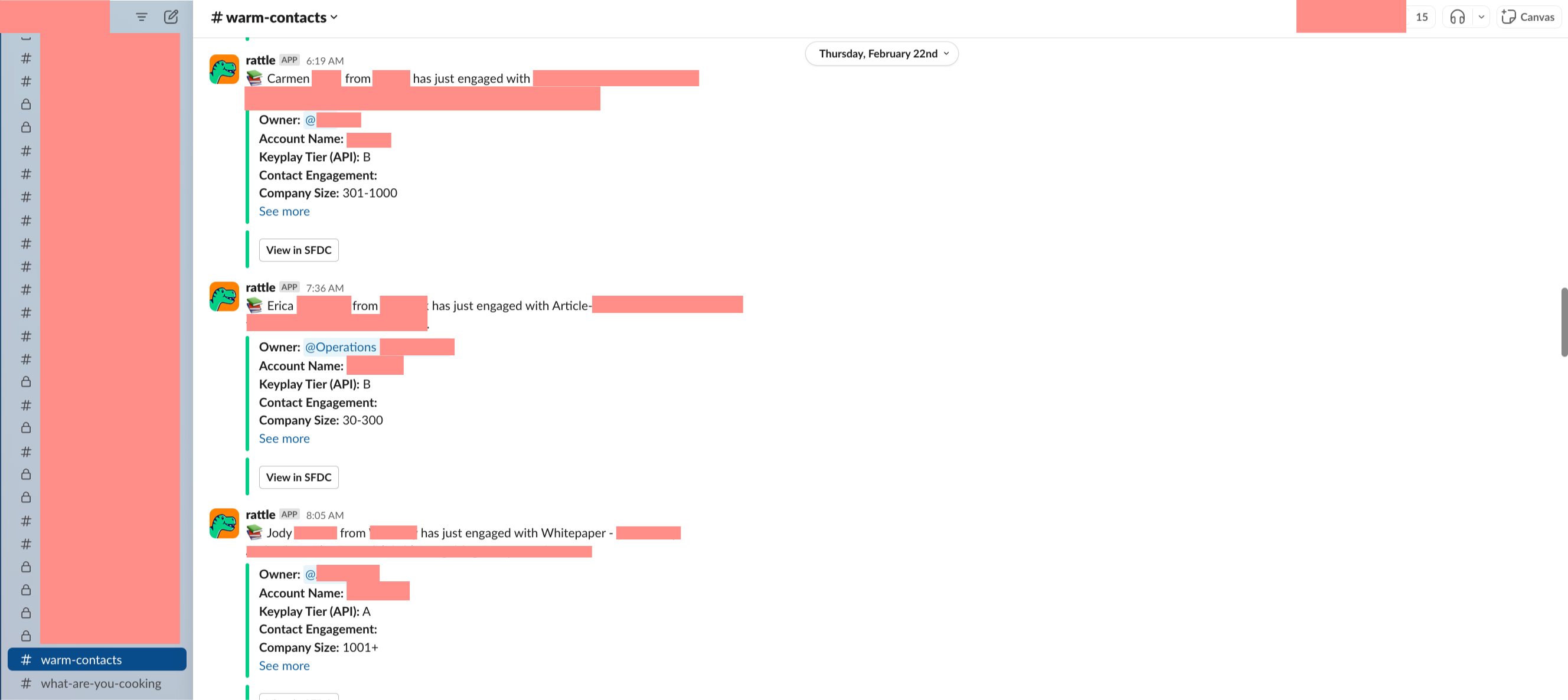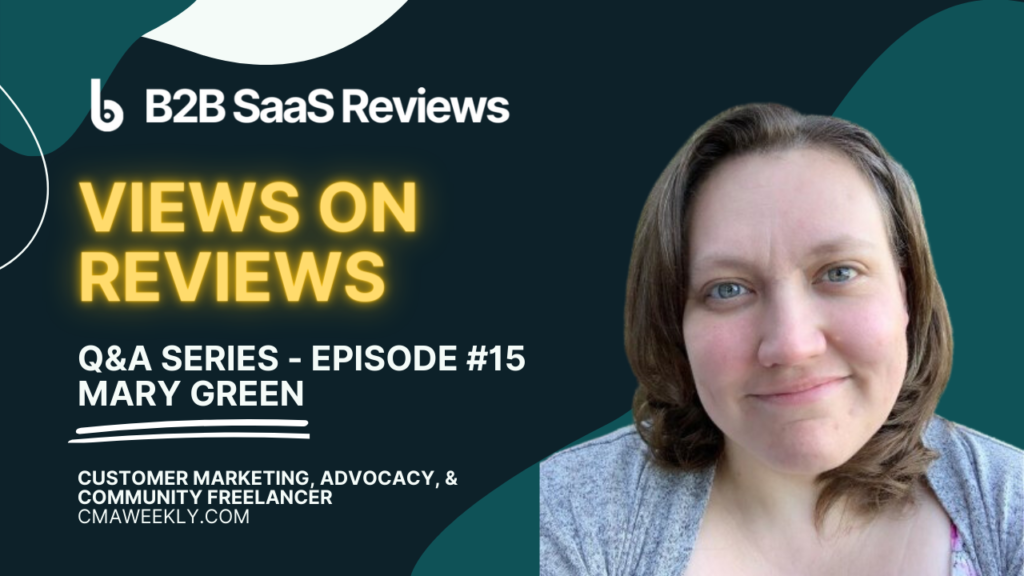If you’re wondering, “can you see who visits your website? ”, you’re not alone.
Only 3% of visitors fill out a form to “self-identify” on a website.
There will be many cases in which you track the collected data, monitor the behavioural trend of the visitors, and track B2B leads but your audience will be there.
You may not exactly identify individual visitors due to privacy issues, but you would do so in a way that is respectful of GDPR and individual privacy, all in one place.
In this article, I’ll cover the potential of website visitor tracking and then look at the limit when it considers how this can be most effectively leveraged to understand, in an ethical way, what is going on within one’s website traffic.
Key Takeaways
- The main takeaway is that while individual user identification is limited due to privacy laws and regulations, visitor tracking software can help you identify from which companies your website visitors are with.
- In other words, legal compliance, such as GDPR, should guide the process of identification of the website visitors, if the practice is to be regarded as ethical and lead towards non-personal, organizational-level insights.
- Website visitor tracking software can help you optimize your marketing and sales strategies based on the online behaviour of your buyers, from your first-party data (your website) to second and third party intent data suppliers.
The Reality of Identifying Website Visitors
As we examine the digital traces left by website visitors, we must recognize the limits that privacy concerns impose.
While it can be tempting to pinpoint and directly go after every individual who lands on your pages, the truth is most users remain shrouded in anonymity, only surfacing when it’s their time to shine.
One often overlooked truth is that even the most sophisticated website visitor tracking software is bound by the imperative to protect user privacy.
While it lies within our reach to find out a visitor’s location to a city through the same IP address, it is not within our reach to do so as far as singling out persons are concerned.
However, there are also silver linings—for instance, website analytics tools can aggregate and anonymize the data to respectfully use the user’s information, at the same time providing the owner with trends and behavior of visitors and company-level identification for ABM and sales outreach.
This data informs how to shape your digital presence in line with what your audience wants and needs. Every webmaster has to find a balance between the work necessary to extract these insights from users’ behavior and users’ privacy respect.
Individual vs. Company Identification
In the search of individual visitors that qualify as potential customers, it’s a bit like finding a needle in a haystack, as only a fraction would fit into the ideal customer profile, and fewer still offer readily available firmographic information.
Yet, the digital world offers alternative paths to identify individual visitors. This enables the identification of businesses due to the ability to pick out unique IP addresses that can then be tracked back to businesses using website visitor tracking tools and reverse IP lookup to serve as a portal into the B2B realm.
Despite the absence of personal details, engaging with website visitors is not a lost cause. You can tie together the visited IPs to the ideal customer profile contacts you should try to connect with at each identified company.
In other words, the website visitor identification software helps you know which companies visit your site, and your sales intelligence tools help you find the right people to contact at those companies, i.e. the contact details like email and phone numbers of the key decision-makers within the organization.
While the person behind the individual may still remain a mystery, there is a possibility for these collective footprints to be translated into something actionable for marketers and sellers.
Data Protection Regulations
The proverbial elephant in the room, so to speak, is compliance with regulation—or often, compliance with regulations—that dictate(s) data protection, such as the General Data Protection Regulation (GDPR) within the European Union.
This is where tools for identification like LeadFeeder tread: steering clear of personal-level identification while focusing on identifying the company visitors, and then providing contact level data for you to find the right people to try (but not identify who specifically from the company was on your site.)
This approach makes it fully compliant with the GDPR, which is more than ticking a legal box; it emphasizes the trust between you and your audience. By respecting these boundaries, companies ensure that their website visitor tracking efforts are both ethical and effective.
Essential Website Visitor Tracking Methods
But the cloak of anonymity through which visitors hide is not impenetrable; well, there are ways that prove useful to find out who has been visiting your website. The key to unlocking this information lies in the various visitor tracking methods available to website owners.
From the pages they visit to the profiles they look at, these methods provide a treasure trove of data that can propel lead generation and sales.
Employing website visitor tracking software offers several benefits, including:
- Collecting user data through installed scripts and reverse domain name system (rDNS)
- Customizing landing pages for different traffic sources to refine targeting and effectiveness of marketing campaigns
By utilizing these tools, you can transform your website into a magnet, drawing in and identifying potential customers.
I’ll start with the main tool for the job: Google Analytics.
Google Analytics
Google Analytics, now also known as GA4, stands as a sentinel, collecting a wealth of data through JavaScript tags that track and record user interactions.
The information gathered is beamed to Google’s servers so GA4 users can gain a comprehensive overview of website performance, user engagement, and the efficacy of marketing campaigns.
With the ability to generate in-depth reports on metrics such as user numbers, session durations, and goal completions, Google Analytics is the starting point for most on the journey to understand who visits their website.
However, with great power comes certain limitations (that’s the saying, right? ;))
In 2020, the release of Google Analytics 4 (GA4) meant more would be done with machine learning and less with third-party cookies to bring about better data accuracy in a digitally transforming space.
Translation: you still can’t really see who’s visiting your site with Google Analytics.
So, while GA4 has powerful data visualization tools, alone it doesn’t provide the providing company-level insights desired by many sales and marketing teams, hence the need the integration of additional tools to bridge this gap.
IP Tracking & Reverse IP Lookup
Just imagine if you could pull a curtain up on your website to show you exactly what actors are on the stage. You would see the companies from all over the world who are behind those IP addresses visiting your website.
This is where IP tracking and reverse IP lookups come into play, giving an almost peephole way into B2B identification.
By implementing a simple script on your site, visitor tracking software like LeadFeeder can:
- Analyze visitor IPs
- Identify the companies they represent
- Unlock potential leads
- Tailor marketing strategies.
With the help of techniques like reverse DNS (rDNS), these tools can collect information about the company a user’s IP address belongs to, providing sales teams with actionable insights.
Tools like Leadfeeder, Visitor Queue, and Clearbit Reveal provide reverse IP lookup to help vendors identify more website visitors (at the company-level).
Beyond company-level tracking, by monitoring the industries that show increased engagement with your website, you can discover new markets, and focus outreach efforts on new areas of opportunity.
User Behaviour Analysis Tools
This goes beyond the level of IP addresses, with many tools for the advanced analysis of user behavior, such as heatmaps and session recordings (Hotjar and VWO), offering you a more detailed picture of your visitors.
The clickmap and the scrollmap are both heatmap tools that visually narrate the areas in your website that are capturing the most activity to hone in on your site’s design and content.
Session recordings are something akin to a play-by-play for user interactions with a granular look at patterns and potential distractions.
They can help uncover reasons bounce rates are high, such as slow page loads or a confusing UI, presenting opportunities to improve the visitor experience and therefore potentially improve conversion rates.
They could be helpful, of course, though they have their downsides. They are not really telling you, for instance, which company could be coming to your site for a visit. But combined with IP tracking, it gives a clearer picture of your visitor’s behaviours.
Choosing the Right Website Visitor Tracking Software
Getting the right visitor tracking software for your business is not a walk in the park.
It warrants careful consideration to focus on the criteria that would be needed to suit your particular business needs and objectives. The considerations range from the kind of data to be collected, how they will be organized, and how scalable the tool is.
And, of course, the cost. To make sense of it for your business, you need to determine the general price range for this type of tool (generally four-figures per year, but could range from three-to-five figures), and then figure out internally whether you can afford it.
I’ll now cover some of the key features to consider and some popular visitor tracking solutions that may meet your needs.
Key Features to Look For
When evaluating website visitor tracking software, CRM integration emerges as a biggie for many, certainly in B2B.
It helps create a flow from visitor data into sales workflows and further enhances detailed analysis of visitor behaviour.
Tools such as Visitor Queue or Factors.AI are examples of a trend toward solutions that combine in-depth website analytics with CRM intragations.
Data management is equally important in a solid visitor tracking system, with sophisticated machine learning enabling company identification accuracy to the next level using platforms such as Clearbit Reveal.
Just as important is the ability to allow room for customizations, as it would enable businesses to take charge of personalizing the data collection at their own time and the way it needs, so that information or insight that may be gained is relevant as much as possible.
Last, but not least, this means ease of use represented through user-friendly interfaces and multi-format lead export options must be in place so that your software helps your team rather than hurts them.
Popular Visitor Tracking Solutions
The market offers quite a few visitor tracking software systems, each developed for a specific tracking aim and meeting different business goals.
For instance, HubSpot Marketing Hub will track individual visitors only in the case where there they have previously converted, and connects to your CRM system, HubSpot or other. It will also give you high-level company identification data.
On the other hand, a tool like Leadfeeder specializes in identifying visiting companies using first-party intent data, providing more in-depth info, through its CRM integration and contact information for potential decision-makers.
Visitor Queue offers an afforadble option that scales with the number of companies tracked. For example, 100 companies/month costs $31/month (annual) and 2,000 companies/month costs $239/month.
Ultimately, anyone of these solutions can help turn anonymous clicks into signals of possibly in-market companies looking for your solution.
Leveraging Visitor Data for Sales and Marketing Success
Data mined from your website visitors is gold in guiding and optimizing your sales and marketing strategies.
Understanding what marketing approaches attract your audience and what products and services they may be interested in helps you fine-tune your user experiences. It can also help you maximize digital advertising efficiency by converting more clicks to customers.
It enables one to identify the visitor of the website, which is important in generating leads and furthering the effectiveness of the sales process, as it gives the sales and marketing teams the insight to captivate the prospective client.
This then serves as the compass guiding both marketing and product team in the drive to increase customer engagement and shape the product.
Tracking qualified account interactions, sources of traffic, and levels of engagement grants a clear view of marketing campaign performance, informing future strategies
I’ll now cover how strategic use of visitor info can be helpful in optimizing marketing efforts and increasing sales performance.
Optimizing Marketing Campaigns
Segmenting website visitors based on behaviours and enriching data using ‘ideal customer profiles’ helps craft laser-focused marketing strategies that resonate with your audience.
Personalizing campaigns to align with the customer journey not only increases their effectiveness but also boosts conversion rates, turning casual visitors into loyal customers. Comprehensive visitor profiles enable a more strategic content approach, especially when dissecting traffic sources to fine-tune marketing tactics.
Tracking your website performance helps reveal new opportunities and allows for better SEO, content strategies, and outreach to identified accounts. Utilizing unique URLs for campaigns can also collect source data, aiding in visitor identification and enhancing audience segmentation.
Understanding user behaviour and preferences can help evaluate your marketing campaigns from good to great.
Enhancing Sales Efforts
The insights gleaned from website visitor tracking are not just vanity metrics for marketing teams; they can be actionable for sales teams.
Sales teams, equipped with user behaviour analytics, can tailor their approach to align with visitor interactions and preferences, creating a more personalized and effective sales outreach messages that hit the mark. By considering web tracking data ,such as page views and visit recency, sales teams can prioritize outreach to the most engaged prospects, thereby increasing the likelihood of conversion.
Visitor tracking software can be a vital part of the sales process to enhance conversion rates and lead generation by overcoming the fact that so few website visitors self-identify.
It becomes imperative, then, for sales teams to harness the power of visitor tracking tools to identify and engage with the companies that visitors represent, find and engage the right contacts at these companies, and ultimately win them as new customers.
Practical Tips for Maximizing Visitor Identification
Getting the most out of visitor identification takes more than the right tools — you also need the people and processes that can compel visitors to self-identify, or “reveal themselves”.
Employing advanced tracking tools like visitor identification software, website cookies, and session replay software can help you gather a more detailed picture of your visitors. Interactive elements such as polls and quizzes not only engage users but also encourage them to share valuable information about themselves.
Designing webpages that are both intuitive and engaging can increase the time visitors spend on your site, boosting the chances of identifying them.
Integrating your website tracking tools with your CRM platform helps get contact records enriched with valuable behaviour data, providing a fuller picture of each visitor.
By using marketing automation tools to act on collected data in real-time, you can:
- Trigger personalized communications that resonate with each visitor’s actions
- Send targeted emails based on specific behaviours
- Display personalized content based on visitor preferences
- Recommend products or services based on past behaviour
These strategies can help you create a more personalized and engaging experience for your website visitors.
Now, I’ll cover specific strategies for encouraging form submissions effectively and leveraging social media and email campaigns.
Encouraging Form Submissions
One of the best ways to identify more website visitors is through form submissions. Optimizing this process helps get for maximizing conversion rates.
By designing forms that are user-friendly and straightforward, with as few fields as possible, compelling copy, and simplified password requirements like single sign-on or magic links for user login, you can significantly increase the likelihood of visitor engagement. Long dropdown lists, especially on mobile, can deter users; instead, allow for multiple formats for inputs and handle the formatting backend to reduce user errors.
Utilizing inline validation and clear, well-placed error messages can significantly improve user satisfaction with forms, guiding them effectively through the submission process.
You can also add microcopy to clarify field names, create two-step forms, and use progress indicators to show how close users are to completion.
By using social proof on form pages, you can earn trust and credibility, encouraging users to take the final step and submit their information.
Also, you can use marketing chatbot software like Intercom, HubSpot Marketing Hub, and Ada to convert more anonymous website visitors.
Utilizing Email Campaigns
Email campaigns, with their ability to deliver personalized content directly to a user’s inbox, serve as an excellent tool for actioning the visitor tracking engagement data.
By carefully crafting calls to action and monitoring responses, you can segment your audience based on their behaviour, leading to more refined and successful marketing efforts.
The integration of insights from email interactions creates a more holistic profile of visitors, enhancing the potential for optimized marketing and sales strategies for marketing and sales teams.
See who visits related sites: Second-Party and Third-Party Buyer Intent
But what about seeing other sites companies from my target audience are visiting?
Second-party and third-party buyer intent data provide a perspective that extends your reach into the broader digital ecosystem.
Review sites like G2, TrustRadius, and Gartner Digital Markets, for example, provide second-party buyer intent data to vendors about who visits their profile or category pages, and even competitor’s profiles.
This data is a goldmine for vendors as it reveals the interests and intentions of potential buyers actively researching in their domain.
Third-party buyer intent data takes this concept even further by aggregating user behaviour across a wide array of sites within a data co-op, as done by companies like Bombora, TechTarget and ZoomInfo SalesOS.
This allows businesses to:
- See who’s visiting pages on topics relevant to them across the internet, not just on their own site
- Identify trends
- Gauge interest levels
- Engage with prospects who are already in the process of seeking out solutions in their market, even before they land on their own website.
By leveraging this type of data, companies can gather data, gain valuable insights, and target their marketing efforts more effectively.
Frequently Asked Questions
Can a company tell if I look at their website?
Not exactly. When you visit a website, the owner can see information like your IP address, the pages you viewed, and the time spent on the site through website analytics tools, and other information gathered during your visit, but privacy rules and regulations prevent companies from tracking personal data on anonymous visitors. If you complete a form on a website, companies will be able to track your website activity. So it depends what you do on their website.
How can I see who is visiting my website?
You can use one of the best website visitor identification tools to identify the companies visiting your website and obtain the contact information of the right people for you to reach out to (though to be clear, not the individuals who were on your site), allowing you to gain valuable insights into your website traffic and adjust your sales marketing efforts accordingly.
How does GDPR affect my ability to track website visitors?
GDPR, which governs data in Europe, requires visitor tracking techniques to comply with policies based on organizational-level identification, not the collection of personal information in a manner that would jeopardize the privacy of the people using its services. Many other countries have GDPR-like data privacy laws. This does to an extent impact a company’s ability to track website visitors.
How can visitor tracking data be used to improve marketing campaigns?
Using visitor tracking data allows for audience segmentation, personalized campaigns, performance tracking, and the ability to target people at companies you’ve identified on your website, leading to more targeted and effective marketing strategies.
What is third-party buyer intent data, and how can it benefit my business?
Third-party buyer intent data provides valuable insights into the interests and trends of prospects actively seeking solutions in your market on other sites through a second party who provides the website data of a collection of other sites, as Bombora and TechTarget do through their co-ops of hundreds and thousands of sites. It can help your business by identifying more potential opportunities with in-market buyers and engage with them effectively with a message tailored by your understanding of their interests through their website behaviour.
Author
-
I'm the Founder and Editor-In-Chief of B2B SaaS Reviews. I'm also the Director of Demand Generation at PartnerStack, the #1 platform purpose-built for partner management and affiliate marketing in B2B SaaS. Before PartnerStack, I worked for other go-to-market B2B SaaS companies: Influitive (Advocate Marketing designed to generate more reviews, references, and referrals), LevelJump (Sales Enablement) (acquired by Salesforce) and Eloqua (Marketing Automation) (acquired by Oracle).











